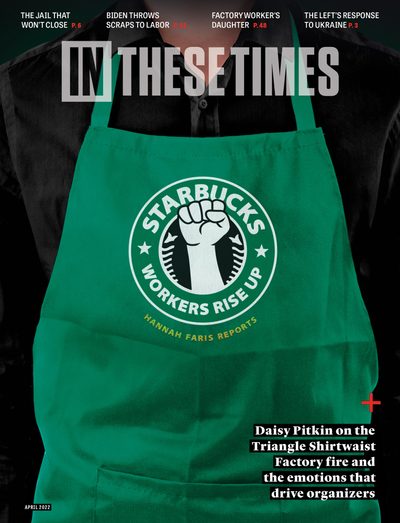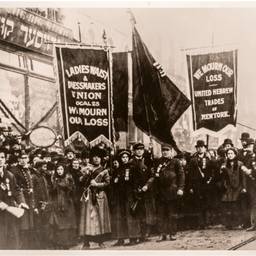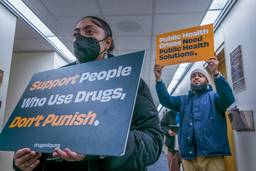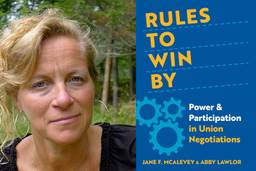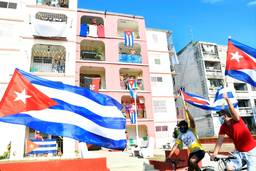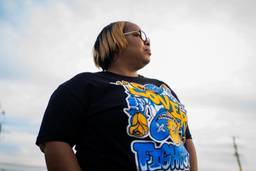How To Build Fierce and Worker-Centered Unions
A Q&A with an organizer about her new book and on building worker power through resilience.
Paige Oamek
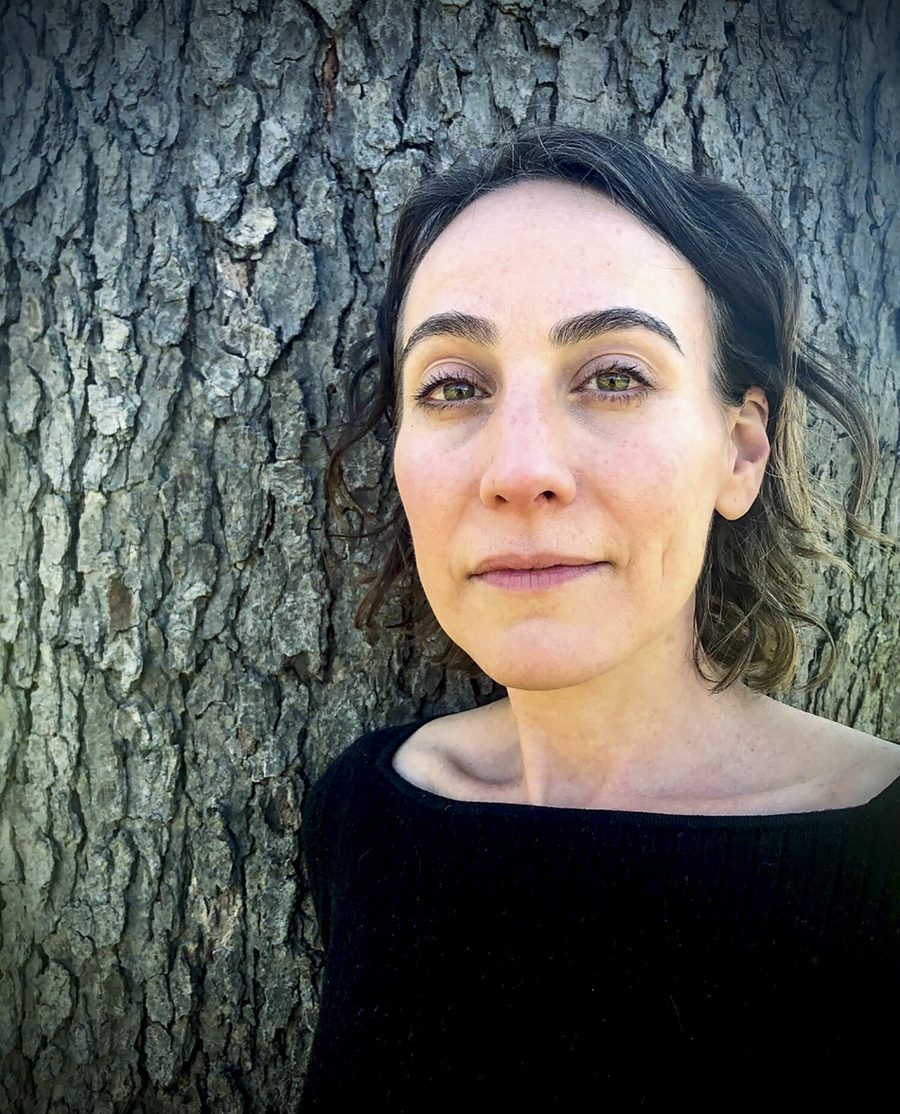
Daisy Pitkin has been a community and union organizer for more than 20 years, in her first book On the Line: A Story of Class, Solidarity, and Two Women’s Epic Fight to Build a Union, she chronicles her time organizing industrial laundry workers in Phoenix, Arizona.
The book is available on March 29th through Algonquin Books, with a chapter excerpted by In These Times. Currently, Daisy lives in Pittsburgh and works as a staff organizer with Workers United.
In On the Line, you talk about how you got caught up emotionally during an organizing training while discussing the Triangle Shirtwaist fire. Can you talk more about, as a staff organizer, the tension between evoking emotion in others and experiencing it yourself?
DP: In the early 2000s, UNITE was a small, scrappy union that put an immense amount of resources into new organizing. They had small teams of organizers who flew around the country and lived in hotels and motels and spent their life organizing. I think it’s really important for unions to be oriented in that way, to have just about every arm focused around new organizing and building the labor movement and having militant sites.
At the same time, we have to really think critically about the role of organizers. Organizing can be such a science: We assess things, map workplaces, determine our tactics. Our tactics add up to be our strategy. It’s all very methodical and stripped of emotion. I write about standing up in front of the group and telling the story of the Triangle Shirtwaist fire, which is something organizers in UNITE get trained to tell. It’s part of the union and its history and its own mythos. So we hear that story as young organizers, we learn how to tell that story to move people to action — move them to sort of build solidarity with each other — and we’re not really supposed to be moved by those stories. I can’t do it that way and some of the best organizers I know can’t do it that way.
I think the role of the emotional momentum of people who work inside the union is worth examining.
This model, of using trauma as a motivating factor, sounds difficult. What’s an alternative?
DP: We learned as organizers that anger is one of the only emotions strong enough to move people, but I don’t think that’s true. I think we can build unions that function differently — in terms of making connections and building solidarity on the sidelines — if we can tap into other emotions and bring them into the organizing process. There’s potential for hope and care for each other, mutual respect and love, even. All good organizing tears an old structure down while building something new. In the process, we are reverse engineering the narratives, so deeply ingrained in our minds, about power and agency at work.
What does that look like, to reverse-engineer narratives
about power?
DP: When I first started organizing, it seemed right to think that, if we take power away from the boss, then the power is ours. But we actually don’t want the kind of power the boss has. It’s authoritarian; it’s paternalistic. The kind of power workers build with each other is built over time and through relationships, and not even through the sexier moments of organizing where we’re marching or rallying. It’s the quieter moments, when you’re just sitting in the car with someone driving around the city for hours, looking for their coworkers. Those slower, time-consuming moments are what actually build the structure of power we’re interested in, to reorganize communities and workplaces around solidarity and collectivity, rather than the sort of top-down power the boss has.
It’s worker-centered because workers and their relationships are at the center of it, but our job, as staff organizers, is to not get in the way of that. You see this with the Starbucks campaign right now, it’s so partner-driven.
In On the Line, you’re recounting your experience in union organizing more than a decade ago, what has changed in the labor movement that might lead us towards creating better worker-centered campaigns?
DP: I think what changed initially is that we slowed down a lot. We weren’t focused on big, bold, experimental external organizing like we were doing in Phoenix for UNITE. We see that in numbers nationally, the decline in new members and elections filed continued.
But I think we’re at a moment now that’s really interesting. There’s a lot of energy among young people, Starbucks workers are calling themselves Generation U. It’s a convergence of forces, the pandemic, the ‘Great Resignation’, workers are demanding more and meanwhile, the approval of labor unions is at its highest point since the 1960s. How do we transform that into a moment where people were actually building unions? I think the Starbucks campaign is really a test of that, how can we help them turn that energy into power?
Democratizing knowledge is really key, a reason unions and campaigns are top-down is that labor law is so broken and difficult, it takes a lot of expertise (not a word that I really love).
In Phoenix, we very much used the NLRB strategy in those campaigns, it made them very long and grueling and difficult to win because the process is slow, unfair, and intimidating to workers — a real testament to those workers that they hung in through the whole process.
Speaking of Phoenix, much of this book is written in second person, addressed to Alma. Why?
DP: I started writing letters to Alma in 2011. We weren’t in touch at the time, so I just kind of put them in a box and stashed them away. I saw a picture of her on Facebook seven years later, got in touch and pulled them out. The book organically took that shape because I had all this material that was already written to her in second person. There aren’t many literary accounts of organizing campaigns. The second person address creates a sort of intimacy that invites readers to live inside of the book in a different kind of way.
For people who haven’t read the book, can you say more about Alma?
DP: Alma is the gutsiest worker-leader I’ve ever met. She has a natural charisma that her coworkers in that laundry couldn’t help but respect. No matter what this massive, multi-million dollar corporation would throw at her, she was not backing down. That fierceness is what really carried that campaign through the many years it took to organize those 220 workers. The workers have to confront their own fear about organizing, then confront anti-union campaigns and broken, loopholed labor laws. I really want the book to show what it takes to be someone like Alma.
This interview has been edited and condensed.
On The Line by Daisy Pitkin is available to order here: https://www.workman.com/products/on-the-line/hardback
Paige Oamek is a writer and fact-checker based in New York. Their writing appears in The Nation, The American Prospect and elsewhere.
